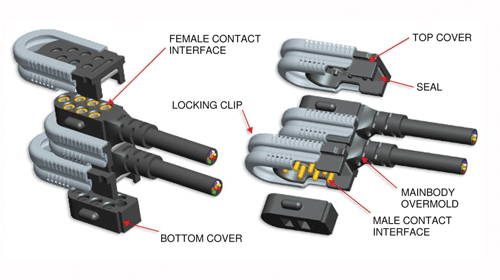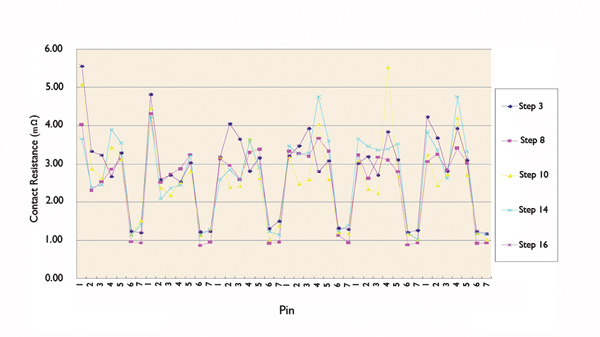Stacking connectors are answering the call for small size and increased functionality
BY TED WORROLL
ITT Electronic Components
Santa Ana, CA
http://www.ittcannon.com/
One of the challenges facing design engineers of electrically powered equipment is managing the tangle of individual wires that are often required to provide power and control signals for various functions. Each power interface—to a battery or main power supply—typically employs a bulky connector, while smaller cables and connectors are used to carry signals for switches, sensors, and other controls.
Multiple power connections in a battery-based system have the effect of shortening battery life and decreasing runtimes due to higher drain losses inherent with multiple connections. In turn, this causes slower and less complete battery recharge cycles.
When multiple cables are used to provide power and signal within a system, each connection also represents a potential vulnerability for failure due to the presence of water, humidity, or other fluids. Similarly, in applications subject to vibration or mechanical stress, conventional connectors can experience unintended disassembly, thus potentially causing system failure. Also, multiple cables often appear unsightly and require extra expense and assembly labor to properly install and test.
Designing and implementing an integrated approach to this type of wiring requires a connection system that is compact, cost-effective, mechanically and environmentally robust, aesthetically pleasing, and most important, does not sacrifice system functionality. Connector engineers are now developing solutions that eliminate multiple power and signal cable connectors for a more-compact cost-effective design.
One solution—the stacking power interconnect—can eliminate up to five different proprietary power and signal cable connectors (see Fig. 1 ). These designs feature a single integrated power connection with a series of stackable connector modules that distribute power and signal throughout the system.

Fig. 1. Stacking connectors, such as this one from ITT, can eliminate up to five different proprietary power and signal cable connectors.Module’s from ITT consist of seven contacts, each capable of handling 15 A. They connect with each other through a series of seven pins/receptacles. Because the contacts are machined, tooling costs are significantly lower for the stacking interconnect as compared to conventional connectors.
Contact geometries
With stacking interconnect designs, contacts can be custom-configured for each application—either terminated to cable cores connected within the module or as feed-through contacts to allow power or signal to be routed to another module/cable in the stack. Contact geometries can be staggered within the stacked modules to meet the needs of specific applications. Stacking connectors with modular designs enable additional accessories or functions to be added to the system simply by plugging in another module, without the need to add a separate connector.
Harsh environments
In addition to cost-effective space-saving designs, manufacturers are also requiring that stacking interconnects be robust in order to suit harsh-environment applications, including automotive, white goods/appliances, and medical. Robust internal designs are achieved by equipping each module of the stacking interconnect device with soldered terminations and built-in cable strain relief. Insert-molded cables that meet IP 67 standards further enhance the design.
Mechanical locking and environmental sealing also contribute to the extended lifespan of stacking connectors. Some stacking connectors feature a sealing gasket between each module combined with a sliding-lock-clip mechanism that provides both a visual confirmation and a positive audible snap when the connector is mated.
Handling the environment
Contact resistance, vibration, mechanical shock, and corrosion are also key factors when designing a robust stacking connector. These characteristics are critical for the efficiency of the signal and low power consumption. Fig. 2 shows the contact resistance for ITT’s stacking connector devices.

Fig. 2. Contact resistance is a critical factor for the efficiency and low power consumption of a stacking connector.
Contact resistance was checked on six cables, seven contacts, for a total of 42 datas. The difference between contacts one through five and six and seven is explained by the difference in the wire gauge of the cable: contacts one through five are 24 AWG, and contacts six and seven are 26 AWG.
It is also imperative that stacking connectors are corrosion-resistant to operate in environments where moisture is a concern. Top- and bottom-cover modules complete the connector assembly by providing the necessary overall sealing. This aids in the extended lifespan of a stacking interconnect module, some of which are rated for up to 1,000 mating cycles. ■
Get more information on connectors for power and signal applications at electronicproducts.com/packaging.asp
Advertisement
Learn more about ITT Electronic Components





